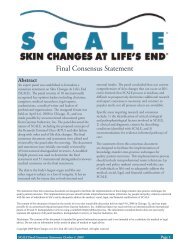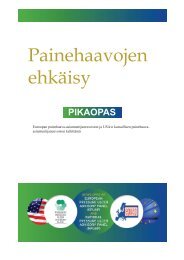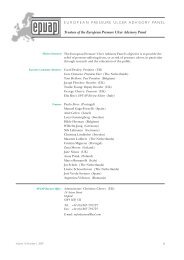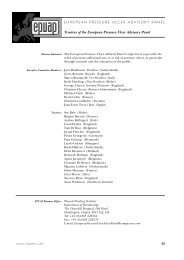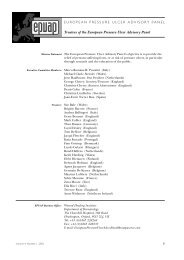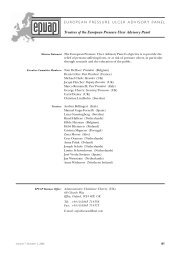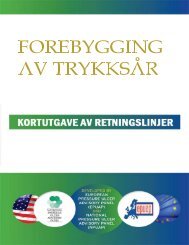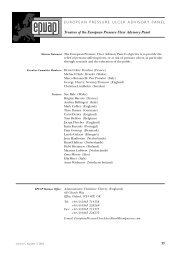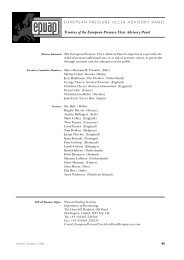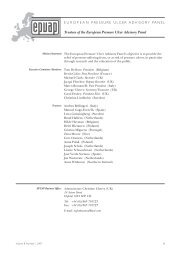Review 6.2 - European Pressure Ulcer Advisory Panel
Review 6.2 - European Pressure Ulcer Advisory Panel
Review 6.2 - European Pressure Ulcer Advisory Panel
Create successful ePaper yourself
Turn your PDF publications into a flip-book with our unique Google optimized e-Paper software.
ABSTRACTS FROM THE 2ND WUWHS MEETING<br />
new guidelines (and knowledge) doesn’t automatically<br />
change our practice. Perhaps this is often due to the way in<br />
which guidelines are disseminated which typically is very<br />
passive. So to achieve the desired changes in health professionals’<br />
behaviour a pressure ulcer guideline may have to<br />
be actively implemented. In this process three elements are<br />
important: the guidelines; the target group; and the context.<br />
Starting with the guidelines: simple guidelines may be<br />
easier to implement than more complex ones. The group<br />
for whom the guideline is intended must have the knowledge<br />
required to understand its recommendations, while<br />
the political, social, organisational and financial environments<br />
must converge to make guideline acceptance and<br />
implementation possible. We know that guidelines can<br />
change the behaviour of health professionals and can exert<br />
a positive impact on patient outcomes, but for these<br />
positive results to be achieved the implementation process<br />
must be effective.<br />
PRESSURE ULCERS 4 (RISK ASSESSMENT) A<br />
NEW (INTRINSIC) RISK FACTOR SCALE AND<br />
ITS USEFULNESS IN JAPAN<br />
T. Ohura (JP)<br />
Purpose: In order to identify the risk factor for pressure ulcers,<br />
a single nationwide case control study was carried out<br />
in Japan. A new (intrinsic) risk factor scale (OHURA-HOTTA)<br />
is advocated as a new assessment tool and its utility is demonstrated<br />
in detail.<br />
Methods: New risk factors were detected from a total of 132<br />
pressure ulcer cases that could be followed up for three<br />
months and then 528 control cases that also met the above<br />
demands were collected from 125 facilities in Japan.<br />
Results: The OH scale considers deterioration of mobility,<br />
morbid bony prominence, edema and joint contracture as<br />
main factors with nutrition and skin moisture as additional<br />
factors. The scale is further classified into three levels according<br />
to the total score. It was confirmed that the onset<br />
probability of pressure ulcers and the healing period of<br />
pressure ulcers correlated to the levels of the scale.<br />
Conclusion: Clinically, the OH scale was useful as a prevention<br />
and prognosis tool for pressure ulcers. Furthermore,<br />
it may work for ‘Clinical Path’, as it can predict the healing<br />
period and onset probability of pressure ulcers. It can help<br />
with both mattress selection and with estimates of the<br />
number of mattresses required by hospitals. The degree of<br />
nursing care in each hospital can be compared with others<br />
using this data. According to the results of a Graphical<br />
Modelling analysis, the risk factors of the OH scale are dependent<br />
on each other. The OH screening tool was proven<br />
to provide more predictive results than previous methods.<br />
PRESSURE ULCERS I (QUALITY OF LIFE)<br />
HUMAN COSTS OF PRESSURE ULCERS:<br />
REVIEW<br />
P. Price (UK)<br />
The development of pressure ulceration is a problem associated<br />
with a number of concomitant conditions and a range<br />
of symptoms, and although little research has been completed<br />
on the impact on everyday life, there is an understandable<br />
assumption that it profoundly affects health-related<br />
quality of life. Qualitative work has shown that the<br />
impact of pressure ulcers is wide ranging, with physical social<br />
and financial aspects affected, whilst changes in body<br />
image and the loss of independence I control are profound<br />
(e.g., Langemo et al 2000). Studies that have used validated<br />
health-related quality of life tools (e.g., Clark 2002, Franks<br />
et al 2002) have used the Short-Form-36 in conjunction with<br />
tests of physical function (such as the Bartel). Franks et al<br />
(2002) have shown that whilst there is a negative impact on<br />
health-related quality of life for patients with pressure ulceration,<br />
this is similar to other patients treated within the<br />
community setting with other conditions. Clark (2002),<br />
reporting on a cohort of 2,507 patients, has highlighted<br />
the difficulties of using generic self-report tools with this<br />
patient population. There are a number of challenges that<br />
professionals in this area need to consider, for example, as<br />
a condition specific tool for pressure ulceration is not available<br />
to use alongside generic tools, then it is difficult to<br />
assess the impact of new treatments in terms of the direct<br />
impact on the patient. Many patients in this group will not<br />
be able to complete a self-report of impact on health-related<br />
quality of life, which raises the issue of the use of proxy<br />
ratings for some patients. In addition to reviewing the current<br />
literature, this presentation will raise questions of methodology<br />
and ethics that related to this important topic.<br />
EVALUATION TOOLS<br />
DESIGN: A NEW EVALUATION METHOD<br />
FOR PRESSURE ULCERS<br />
H. Sanada (JP)<br />
Background: The Japanese Society of <strong>Pressure</strong> <strong>Ulcer</strong>s identified<br />
the need for treatment guidelines to assess pressure ulcer<br />
severity and to monitor the healing process. The society’s<br />
academic committee developed a pressure ulcer severity classification<br />
and healing progression monitoring tool to fulfil<br />
this need. DESIGN is an acronym derived from the six items<br />
used to classify and assess wound-healing progress: Depth,<br />
Exudate, Size, Infection, Granulation, Necrosis. P is added to<br />
the acronym when a pocket (undermining) is present.<br />
Objective: This study reviews the validity and reliability of DE-<br />
SIGN, a tool for classifying pressure severity and monitoring<br />
progression towards healing. Only the tool’s healing<br />
progression component was evaluated.<br />
Method: Inter-rater reliability was evaluated by calculating<br />
the agreement rate of scores, based on eight photos of pressure<br />
ulcers and six actual ulcers, made by a panel of seven<br />
nurses. Validity was assessed, using the same eight photos,<br />
by comparing DESIGN scores with those made using the<br />
validated <strong>Pressure</strong> Sore Status Tool (PSST).<br />
Results: The DESIGN inter-rater reliability results showed a<br />
high correlation of r = 0.98 for the photos and r = 0.91 for<br />
the real-life patients with pressure ulcers, respectively, for all<br />
raters based on total scores. For validity, a correlation greater<br />
than 0.91 was found between the DESIGN and PSST scores.<br />
Conclusion: Based on our results, DESIGN was found to have<br />
both high inter-rater reliability and high validity among the<br />
seven nurses who quantitatively evaluated the wound-healing<br />
progress of the pressure ulcers in this study.<br />
Volume 6, Number 2, 2004 53



